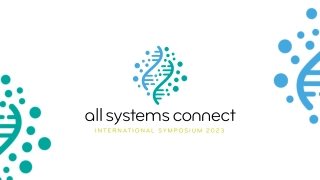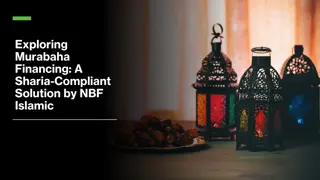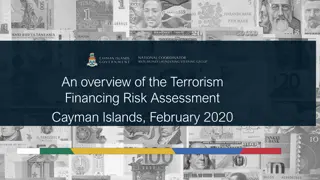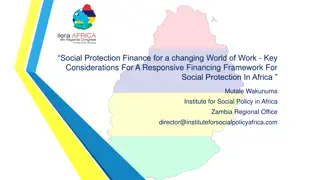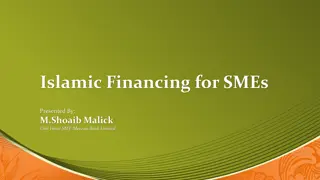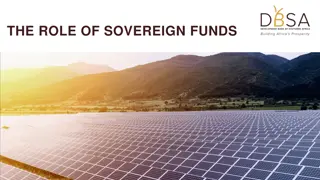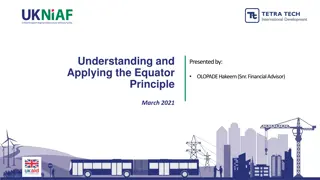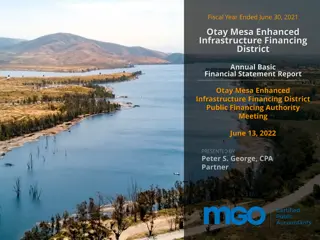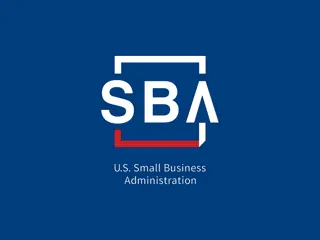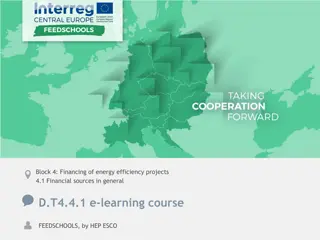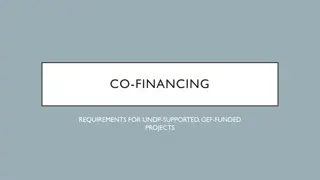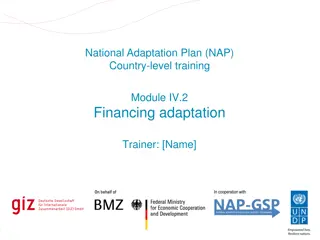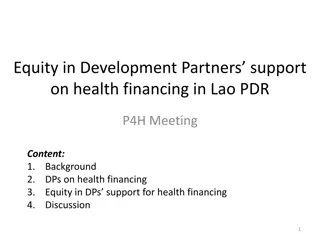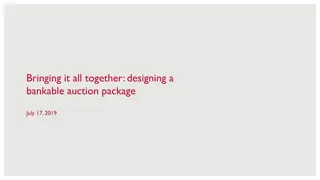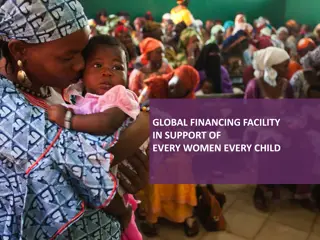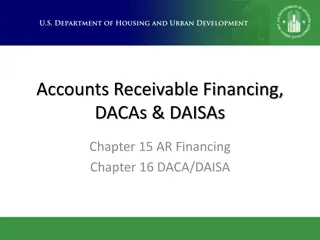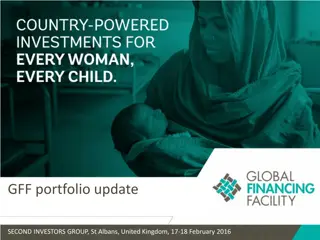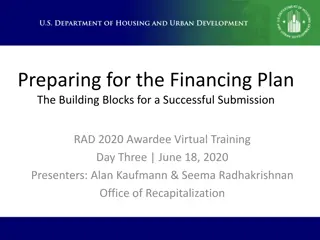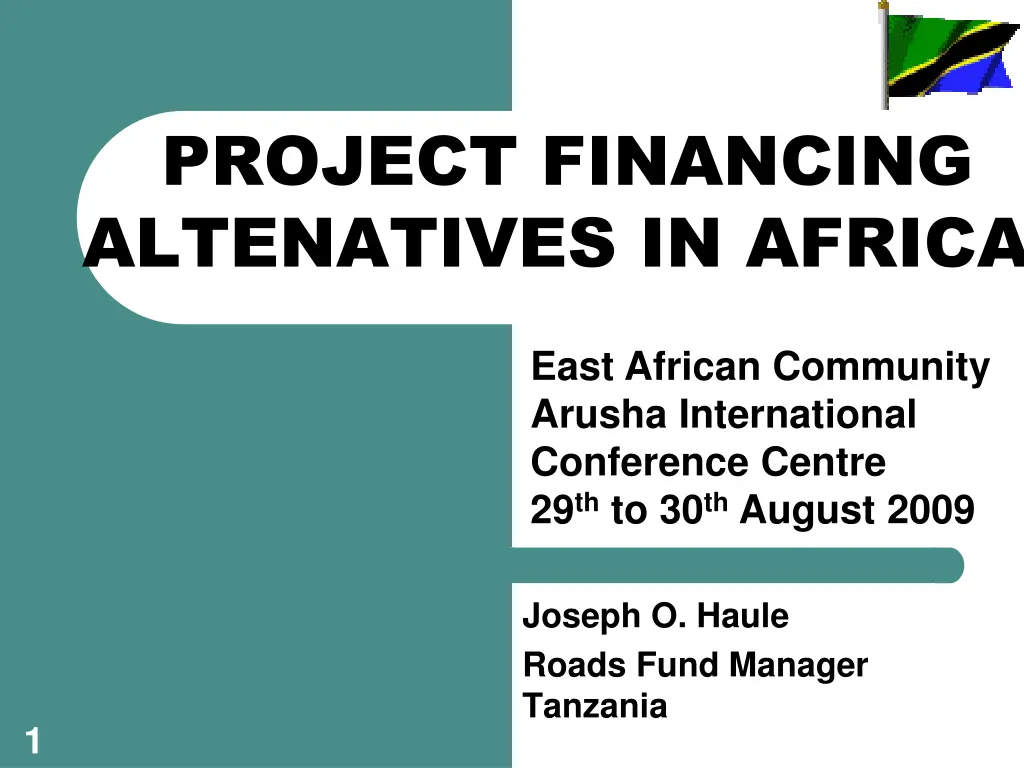
Infrastructure Financing Challenges and Recommendations in East Africa
Explore the challenges and recommendations for infrastructure financing in East Africa, focusing on alternative mechanisms and the financial needs of various sectors. Learn about the funding requirements for transport infrastructure, the importance of infrastructure investments in sub-Saharan Africa, and specific data on Tanzania's transport needs. Discover insights from a WB study recommending increased infrastructure investments to achieve sustainable development goals.
Download Presentation

Please find below an Image/Link to download the presentation.
The content on the website is provided AS IS for your information and personal use only. It may not be sold, licensed, or shared on other websites without obtaining consent from the author. If you encounter any issues during the download, it is possible that the publisher has removed the file from their server.
You are allowed to download the files provided on this website for personal or commercial use, subject to the condition that they are used lawfully. All files are the property of their respective owners.
The content on the website is provided AS IS for your information and personal use only. It may not be sold, licensed, or shared on other websites without obtaining consent from the author.
E N D
Presentation Transcript
PROJECT FINANCING ALTENATIVES IN AFRICA East African Community Arusha International Conference Centre 29th to 30th August 2009 Joseph O. Haule Roads Fund Manager Tanzania 1
Structure of Presentation The underlying problem Alternative Financing Mechanisms Experiences/ Lessons Conclusion and Recommendations 2
Africa Infrastructure Needs CAPITAL EXPENDITURE OPERATING EXPENDITURE US$ BN. PA OVER 10 YEARS 0.8 0.7 23.2 10.7 2.7 38.1 Source: Africa Infrastructure Country Diagnostic Study Annual Report 2007 US$ bn. pa over 10 years P TAGE GDP P TAGE GDP ICT 0.1 0.2 4.2 1.7 0.4 6.6 1.1 - 19.4 9.6 7.3 37.4 0.2 - 2.4 1.5 1.2 5.3 IRRIGATION POWER TRANSPORT WSS TOTAL 3
Financing requirement for transport Financing requirement for transport infrastructure in Selected Countries infrastructure in Selected Countries TITLE RURAL CONNEC TIVITY US$ MILLION PER YEAR REGION AL CONNEC TIVITY NATIONA L CONNEC TIVITY URBAN CONNEC TIVITY AIRPORT , PORTS AND RAILWAY S 70.5 TOTAL CONGO- DRC ETHIOPI A KENYA LESOTH O MALAWI MOZAMB IQUE NAMIBIA 155.8 196.3 968.7 29.6 1 420.9 89.2 66.7 457.7 38.1 27.4 679.1 71.9 0.1 80.5 24.3 215.3 8.3 72.4 2.6 133 29.7 573.1 65 30 97.1 38.8 49.8 70.2 383.6 10.2 22 21.6 67.2 170.8 619.7 91.8 25.3 250.9 3.3 59.5 430.8 4 Source: Africa Infrastructure Country Diagnostic, 2007
Africa Infrastructure Needs WB study recommends infrastructure investments in sub-Saharan Africa should exceed 5% of GDP to achieve the UN Millennium Development Goals (US $40 bn) 4% of GDP should be added for operation and maintenance to ensure sustainability of infrastructural investment (US$ 40bn) Compared to Brazil and India launched US$ 75bn and US$100bn respectively 5
Tanzania Transport Needs Phase Tanzania Transport Needs Phase 1 1 FY FY FY FY FY PROGRAMME COMPONENT Roads SN 1 2007/08 2008/09 2009/10 2010/11 2011/12 TOTAL 646.3 695.88 814.60 965.62 1,106.95 4,274.87 2 Air Transport 39.09 48.09 57.23 78.44 79.44 303.29 946.46 3 Railways 63.32 139.46 163.22 294.55 285.91 4 Maritime Transport Institutional Support Cross Cutting Issues 52.21 114.55 114.43 88.52 87.44 456.83 5 28.47 33.91 30.55 30.84 33.31 157.57 6 53.50 10.70 10.70 10.70 10.70 10.70 840.09 1,042.59 1,190.73 1,469.67 1,603.45 6,192.52 GRAND TOTAL 6
Tanzania Transport Needs Tanzania Transport Needs WB AICD study US$ 12,989 mill (US$ 1,298.9 Mill annually) required to meet basic scenario US$6,192.52 meets about 46% only of investment required. 8.4 %of GDP equivalent to US$ 156 mill annually required to sustain the level of investment US$ 2,475.17 already secured leaving a gap of UD$ 3,717.35 (60%) or 38% of WB est. 7
The Gap Africa received a minimum $40 billion of external financial support to African infrastructure in 2007 Sectors benefited include telecommunication, water and energy North Africa, South Africa and Nigeria $40 bn for sustainability???? 8
Alternative sources of Road Financing Traditional Sources Private Finance Road Funds Public Private Partnership Construction, Rehabilitation & Maintenance Rehabilitation & Maintenance Construction 9
Sources of Private Finance Banking and Financial Institutions (lenders) Share Holders & Investors (sponsors) Special Purpose Vehicle 10
Financial Institutions Development Agencies- IDA, ADF, JICA etc Multilateral Development Banks- WB, ADB,EIB Bilateral Development Banks- JIBC, KFW Development Finance Institutions- IFC, EADB Funds or other Special Purpose Vehicles- EAIF, KFAED 11
Forms of private sector participation Option* Asset ownershi p Operation s & maintena nce Capital investmen t Commerci al risk Typical duration Service contract Public Public and private Private Public Public 1-2 years Managem ent contract Lease Public Public Public 3-5 years Public Private Public Shared 8-15 years 12
Typical duration Option Asset ownership Operation s & mtce Capital invest t Commerci al risk Concessio n Public Private Private Private 25-30 years Build Operate Transfer Public and private Private Private Private 20-30 years Divestitur e Private or Public and private Private Private Private Indefinite (may be limited by licence) 13
Eligibility of Project financing Eligibility of Project financing products products Equity investments - acquisition of ordinary shares or common stock in a company- PPPs and private entities (Electricity, oil, gas, ICT) Private sector loans- PPPs and private entities Public sector loans- only govt, LGA and Public Institutions Development credit- only government eligible 14
Commitments to Infrastructure Projects 2007 in Africa ICA members increased by 61% to reach $12.4 billion in 2007 ODA increased by 59% to reach $8.17 billion Transport sector received $3.6 billion from $3.2 billion committed in 2006. SSA got $ 3 billion 15
Commitments to Infrastructure Projects 2007 in Africa Commitments to East Africa were $1.3 billion (36%) in 2007, whilst to West Africa fell by 40% EU and World Bank commitments in transport of around $1 billion each. 16
Private Sector Investments in Private Sector Investments in Africa Africa $20 billion from the private sector in 2007. 50% invested in North Africa and South Africa 17
International International PPP Developing Economies: Developing Economies: PPP by by Sector in Sector in Private Investments in LDCs by Sector (1990 - 2006) $70,000 $60,000 Investments ($ Millions) $50,000 $40,000 $30,000 $20,000 $10,000 $0 1990 1991 1992 1993 1994 1995 1996 1997 1998 1999 2000 2001 2002 2003 2004 2005 2006 Energy Telecom Transport Water and sewerage 18 LIR Frameworks for PPPs, May 14-23, 2008
Investment commitments to transport Investment commitments to transport projects with private participation in projects with private participation in developing countries by region, 1990 developing countries by region, 1990 2007 2007 2007 US$ billions Projects 35 140 30 120 25 100 20 80 15 60 10 40 5 20 0 0 1990 1991 1992 1993 1994 1995 1996 1997 1998 1999 2000 2001 2002 2003 2004 2005 2006 2007 East Asia and Pacific Middle East and North Africa Projects Europe and Central Asia South Asia Latin America and the Caribbean Sub-Saharan Africa Source: World Bank and PPIAF, PPI Project Database. 19
PPP Investments in East Africa in US $ Mill. Kenya Tanzania Ugand Rwanda Burun a 8 (937) di 0 7 (355) 8 (509) 2 (2) Energy 6 (3,123) 8 (1,103) 4 (1,012 3 (205) 3 (54) Telecom 4 (457) 4 (178) 1 (404) 0 0 Transpo rt - 1 (9) 2 0 0 Water & Sa 16 (3,935) 21 (1,799) 15 (2,352) 5 (206) 3 (54) Total 20 Source: PPIAF Country data base
Sovereign bonds South Africa Ghana raised international bond in September 2007, raising $750 million. Gabon s first $1 billion bond sold in December 2007 and was priced to pay 8.2% Nigeria, Zambia, Kenya and Uganda 21
Why PPPs PPPs are attractive because: Can increase infrastructure without govt borrowing Can access user charges as additional revenue instead of higher taxes Access innovativeness/technology and efficiency of provision 22
Impediments to Attracting Private Finance Lack of Political Stability and predictability of policies Lack of Legal framework and regulatory environment emphasising: Transparent and competitive bidding Bid evaluated on an NPV basis Provision of international arbitration Poor Healthy economic and financial environment 23
Investment climate Investment climate Country Entry barrier Property right protectio n 3.0 Quality of regulatio n 4.0 Index of political risk Index of judicial efficienc y 0.3 Index of corruptio n Bulgaria 10.0 26.0 4.8 Czech Republic Hungary 10.0 2.0 3.0 22.5 1.3 3.8 8.0 2.0 3.0 19.5 0.3 3.0 Poland 11.0 2.0 3.0 22.0 0.0 2.3 Romania 16.0 4.0 4.0 31.5 0.3 4.5 Turkey 13.0 3.0 4.0 40.5 n.a. n.a. 24 Source: World Bank working paper no.46
Investment climate Investment climate Country Credit worthiness indicators Contract enforcement indicators Degree of Government intervention 25
Ranking on ease of doing business 2009 1 2008 1 Country Singapore 2009 82 2008 78 Country Kenya 2 2 New Zealand Mauritius 111 105 Uganda 24 29 122 124 Tanzani a Rwanda 32 35 South Africa 139 148 38 52 Botswana 177 174 Burundi 51 48 Namibia 181 181 DRC 26 Source: Doing business 2009
What can go wrong Uk Channel Tunnel Rail Link Awarded to bidder with lowest subsidy Euro 8mill equity and debt on Euro 8bill project too optimistic forecast (actual 1/3 of forecast) UK govt forced to provide more subsidy 27
What can go wrong City Water in Tanzania TRL in Tanzania Rift Valley Railway in Kenya and Uganda TICTS in Tanzania 28
Why PPPs Fail World Bank s PPI Database 1990-2001: 48 (1.9%) of 2,500 major PPI projects have been cancelled (3.2% of $754 billion) One third of all cancellations were Mexico s Tollroads Water projects that were cancelled were primarily due to disputes regarding tariff increases 29 LIR Frameworks for PPPs, May 14-23, 2008
Why PPPs Fail Inadequate due diligence Risks not allocated to best suited partner Inadequate capacity within government Transaction advisers recruited too late or changed often No provision for renegotiating, amendments and termination of concession agreement 30
Examples of good PPPs Examples of good PPPs in Transport in Transport Songas in Tanzania N4 Toll Road South Africa to Mozambique Maputo port N4 PLATINUM HIGHWAY SA to Botswana 31
Maghreb Coastal NEPAD indicative NEPAD indicative Spatial Development Spatial Development Program Program First Pass! First Pass! Niger: Dakar Port Harcourt Red Sea - Nile Djibouti Conakry Buchanan Sekondi Ougadougou Douala Mombasa Gulf of Guinea Coastal Libreville Lomie Madagascar Bas Congo Current SDIs RSDIP NEPAD SDP: 1st Pass
How to avoid failures Establish and operate a PPP Unit with: qualified and experienced in project management well remunerated multidisciplinary staff Professional and Politically independent to : Prepare projects, bid documents and manage bid process Negotiate contact and monitor implementation and operation 33
How to avoid failures How to avoid failures C tnued C tnued Transaction advisers hired on long term basis Must have contingency plan and rescue package Guarantees and performance bond Performance indicators and penalty for noncompliance Mechanisms for sharing excessive profits 34
Future work Future work Development of local capital markets: Pension funds Insurance contracts Stock exchanges 35
Conditions for Successful Conditions for Successful PPPs PPPs Build effective, transparent & credible regulatory units to root out corruption Peace and political stability Clear policies and legal framework Thorough feasibility studies of bankable projects with risks identified PPP facilitation units with diverse skills eg. Negotiation skills 36
Thank you for your attention jhaule@raha.com www.roadsfundtz.org 37

